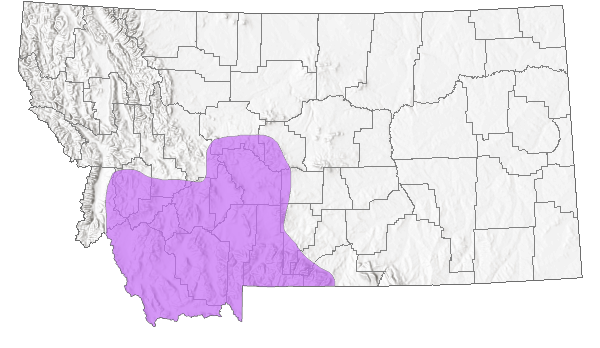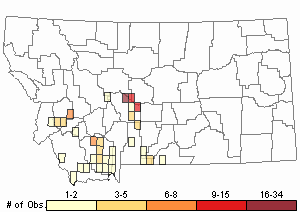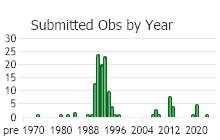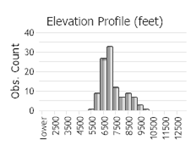View in other NatureServe Network Field Guides
NatureServe
Montana
Utah
Wyoming
Idaho
Wisconsin
British Columbia
South Carolina
Yukon
California
New York
Pink Agoseris - Agoseris aurantiaca var. carnea
Other Names:
Agoseris carnea, Agoseris lackschewitzii
State Rank Reason (see State Rank above)
See rank details.
- Details on Status Ranking and Review
Population Size
Score1 - Moderate: Generally 10,000-100,000 individuals.
CommentAvailable data support a range of 10,000-100,000 plants, though population size may be greater than this range.
Range Extent
Score2 - Regional or State Endemic or Small Montana Range: Generally restricted to an area <100,000 sq. miles (equivalent to 2/3 the size of Montana or less) or Montana contributes 50% or more of the species’ range or populations OR limited to 2-3 Sub-basins in Montana.
Area of Occupancy
Score0 - High: Occurs in >25 Subwatersheds (6th Code HUC’s).
Environmental Specificity
Score1 - Moderate: Species is restricted to a specific habitat that is more widely distributed or to several restricted habitats and is typically dependent upon relatively unaltered, good-quality habitat (C Values of 5-7).
Trends
Score0-1 - Stable to Minor Declines:
CommentTrend are undocumented, though populations are likely stable or experiencing only minor declines.
Threats
Score0-1 - Low to Medium.
Intrinsic Vulnerability
Score0-1 - Low to Moderate Vulnerability.
Raw Conservation Status Score
Score
4 to 7 total points scored out of a possible 19.
General Description
Pink Agoseris is a taprooted perennial with milky sap. Glabrous leaves are clustered at the base, and there are 1 to several leafless stems, 10-60 cm tall, arising from the center; leaves taper gradually to a long petiole, are narrowly lance-shaped, 5-25 cm long, and 10-25 cm wide. Flower heads resemble those of the common dandelion; they are solitary at the ends of the stems and composed entirely of deep pink to light purple ray flowers, ca. 15-20 mm long. Involucral bracts are narrowly lance-shaped, 10-15 mm long, villous, with non-glandular hairs, purple-striped, mottled, and obtuse-tipped. Fruits (achenes) have beaks 1/2 to 2/3 the length of their bodies. Fruits also resemble those of the dandelion; they are spindle-shaped, and the top tapers to a slender beak to which numerous, long, white bristles are attached.
Phenology
Flowering in July and early August, fruiting in late August
Diagnostic Characteristics
Baird [Flora of North America] considers this to be a pink-flowered form of A. aurantiaca. Vegetatively, this plant resembles other members of the genus Agoseris, as well as species of Microseris (Nothocalais), but it can be distinguished by its pink flowers. In fruit, it can be distinguished by a combination of involucral and achene characteristics.
Species Range
Montana Range
Range Descriptions

 Native
Native
Range Comments
Regional endemic of southwest Montana, east-central Idaho, and northern Wyoming.
Observations in Montana Natural Heritage Program Database
Number of Observations: 136
(Click on the following maps and charts to see full sized version)
Map Help and Descriptions
Relative Density

Recency



 (Observations spanning multiple months or years are excluded from time charts)
(Observations spanning multiple months or years are excluded from time charts)
Habitat
Subalpine wet meadows where soil is saturated throughout the growing season.
Ecology
POLLINATORS The following animal species have been reported as pollinators of this plant species or its genus where their geographic ranges overlap:
Bombus bifarius and
Bombus insularis (Wilson et al. 2010).
Stewardship Responsibility
References
- Literature Cited AboveLegend:
 View Online Publication
View Online Publication Wilson, J.S., L.E. Wilson, L.D. Loftis, and T. Griswold. 2010. The montane bee fauna of north central Washington, USA, with floral associations. Western North American Naturalist 70(2): 198-207.
Wilson, J.S., L.E. Wilson, L.D. Loftis, and T. Griswold. 2010. The montane bee fauna of north central Washington, USA, with floral associations. Western North American Naturalist 70(2): 198-207.
- Additional ReferencesLegend:
 View Online Publication
View Online Publication
Do you know of a citation we're missing? Achuff, P. L. and L. S. Roe. 1992. Botanical survey of the Goat Flat proposed Research Natural Area, Deerlodge National Forest. Unpublished report to the Deerlodge National Forest. Montana Natural Heritage Program, Helena, MT. 31 pp.
Achuff, P. L. and L. S. Roe. 1992. Botanical survey of the Goat Flat proposed Research Natural Area, Deerlodge National Forest. Unpublished report to the Deerlodge National Forest. Montana Natural Heritage Program, Helena, MT. 31 pp. Fertig, W. 1993. Pink agoseris (Agoseris lackschewitzii), a newly discovered sensitive plant species from the west slope of the Wind River Range, Bridger-Teton National Forest. [unpublished report]. Wyoming Natural Diversity Database, The Nature Conservancy, Laramie, WY. 15 pp.
Fertig, W. 1993. Pink agoseris (Agoseris lackschewitzii), a newly discovered sensitive plant species from the west slope of the Wind River Range, Bridger-Teton National Forest. [unpublished report]. Wyoming Natural Diversity Database, The Nature Conservancy, Laramie, WY. 15 pp. Henderson, D.M., R.K. Moseley, and A.F. Cholewa. 1990. A new Agoseris (Asteraceae) from Idaho and Montana. Systematic Botany 15(3):462-465.
Henderson, D.M., R.K. Moseley, and A.F. Cholewa. 1990. A new Agoseris (Asteraceae) from Idaho and Montana. Systematic Botany 15(3):462-465. Layser, E. F. 1992. Onion Park Research Natural Area: botanical and ecological resources inventory, mapping and analysis. [Unpublished report to Lewis & Clark National Forest].
Layser, E. F. 1992. Onion Park Research Natural Area: botanical and ecological resources inventory, mapping and analysis. [Unpublished report to Lewis & Clark National Forest]. Lesica, P. 1993. Vegetation and flora of the Line Creek Plateau area, Carbon County, Montana. Unpublished report to USDA Forest Service, Intermountain Research Station. Montana Natural Heritage Program, Helena, Montana. 30 pp.
Lesica, P. 1993. Vegetation and flora of the Line Creek Plateau area, Carbon County, Montana. Unpublished report to USDA Forest Service, Intermountain Research Station. Montana Natural Heritage Program, Helena, Montana. 30 pp. Lesica, P. 2012. New combinations for the Montana flora. Journal of the Botanical Research Institute of Texas 6: 25-27.
Lesica, P. 2012. New combinations for the Montana flora. Journal of the Botanical Research Institute of Texas 6: 25-27. Lesica, P., M.T. Lavin, and P.F. Stickney. 2012. Manual of Montana Vascular Plants. Fort Worth, TX: BRIT Press. viii + 771 p.
Lesica, P., M.T. Lavin, and P.F. Stickney. 2012. Manual of Montana Vascular Plants. Fort Worth, TX: BRIT Press. viii + 771 p. Lesica, P., M.T. Lavin, and P.F. Stickney. 2022. Manual of Montana Vascular Plants, Second Edition. Fort Worth, TX: BRIT Press. viii + 779 p.
Lesica, P., M.T. Lavin, and P.F. Stickney. 2022. Manual of Montana Vascular Plants, Second Edition. Fort Worth, TX: BRIT Press. viii + 779 p. Mathews, S.Y. 1989. Sensitive plant surveys, 1989: United States Forest Service, Region 1, Gallatin National Forest, Montana. Unpublished report to the USDA Forest Service, Gallatin National Forest, Bozeman, Montana. Montana Natural Heritage Program, Helena, MT. 85 pp.
Mathews, S.Y. 1989. Sensitive plant surveys, 1989: United States Forest Service, Region 1, Gallatin National Forest, Montana. Unpublished report to the USDA Forest Service, Gallatin National Forest, Bozeman, Montana. Montana Natural Heritage Program, Helena, MT. 85 pp. Pavek, D. and L.A. Schassberger. 1990. Status review of Agoseris lackschewitzii, USDA Forest Service, Region 1, Gallatin National Forest. Unpublished report to the Gallatin National Forest. Montana Natural Heritage Program, Helena, Montana. 52 pp.
Pavek, D. and L.A. Schassberger. 1990. Status review of Agoseris lackschewitzii, USDA Forest Service, Region 1, Gallatin National Forest. Unpublished report to the Gallatin National Forest. Montana Natural Heritage Program, Helena, Montana. 52 pp. Vanderhorst, J.P. and B.L. Heidel. 1995. Sensitive plant survey in the Tobacco Root Mountains, Madison County, Montana. Unpublished report to the Beaverhead and Deerlodge National Forests. Montana Natural Heritage Program. Helena, MT. 66 pp. plus appendices.
Vanderhorst, J.P. and B.L. Heidel. 1995. Sensitive plant survey in the Tobacco Root Mountains, Madison County, Montana. Unpublished report to the Beaverhead and Deerlodge National Forests. Montana Natural Heritage Program. Helena, MT. 66 pp. plus appendices. Williams, K.L. 2012. Classification of the grasslands, shrublands, woodlands, forests and alpine vegetation associations of the Custer National Forest portion of the Beartooth Mountains in southcentral Montana. M.Sc. Thesis. Bozeman, MT: Montana State University. 376 p.
Williams, K.L. 2012. Classification of the grasslands, shrublands, woodlands, forests and alpine vegetation associations of the Custer National Forest portion of the Beartooth Mountains in southcentral Montana. M.Sc. Thesis. Bozeman, MT: Montana State University. 376 p.
- Web Search Engines for Articles on "Pink Agoseris"





